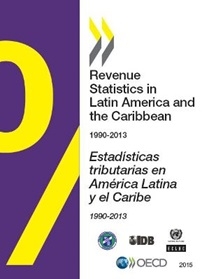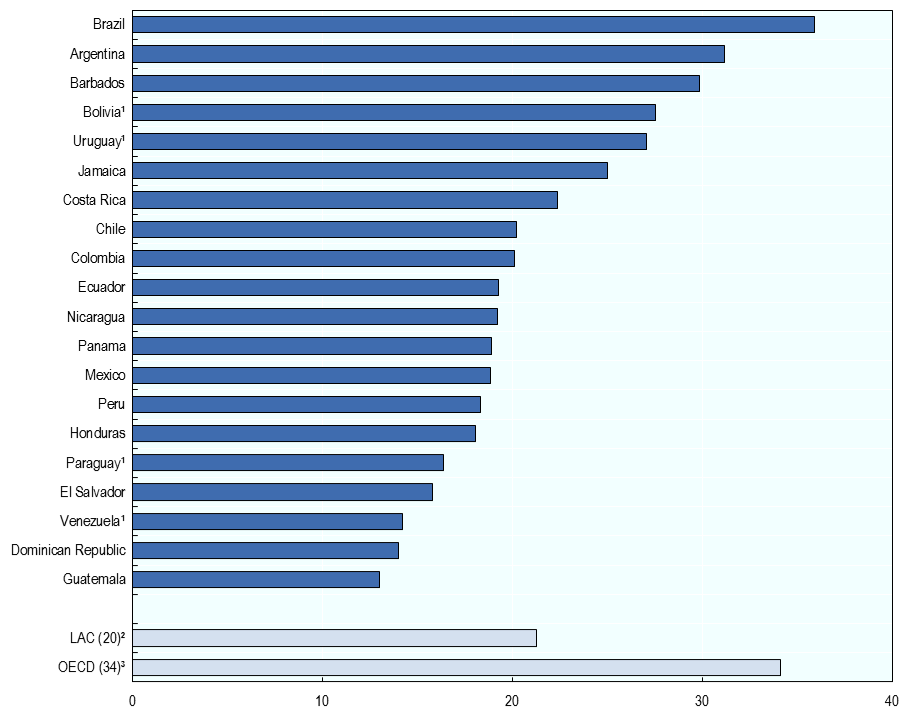Latin America and the Caribbean: Tax revenues remain stable
 Santiago, Chile – 10 March 2015 – Tax revenues in Latin America and the Caribbean (LAC) have remained stable in 2013 and continue to be considerably lower, as a proportion of national incomes, than in most OECD countries. Revenue Statistics in Latin America and the Caribbean 1990-2013 (fourth edition) shows that the average ratio of tax revenue to GDP in the 20 Latin American and Caribbean countries covered by the report1 was 21.3% in 2013, 0.1 percentage point above the ratio in 2012. The tax-to-GDP ratio rose from 19.5% to 21.2% over the 2009-12 period.
Santiago, Chile – 10 March 2015 – Tax revenues in Latin America and the Caribbean (LAC) have remained stable in 2013 and continue to be considerably lower, as a proportion of national incomes, than in most OECD countries. Revenue Statistics in Latin America and the Caribbean 1990-2013 (fourth edition) shows that the average ratio of tax revenue to GDP in the 20 Latin American and Caribbean countries covered by the report1 was 21.3% in 2013, 0.1 percentage point above the ratio in 2012. The tax-to-GDP ratio rose from 19.5% to 21.2% over the 2009-12 period.
The report, produced jointly by the Inter-American Centre of Tax Administrations (CIAT), the Economic Commission for Latin America and the Caribbean (ECLAC), the Inter-American Development Bank (IDB), the Organisation for Economic Cooperation and Development (OECD) and the OECD’s Development Centre, was launched today during the XXVII Regional Seminar on Fiscal Policy, held at ECLAC headquarters in Santiago, Chile.
It shows that tax revenues rose significantly across the region over the 1990-2013 period, pushing the average tax to GDP ratio up by 7 percentage points, from 14.4% to today’s 21.3% level. While this revenue boost has provided governments in the region increased capacity to improve spending on social programmes and physical infrastructure, the tax to GDP ratio is still 13 percentage points below the OECD average of 34.1%, according to the report.
Wide national variations exist across LAC countries. In 2013, the tax to GDP ratios for the 20 LAC countries included in the report range from Brazil (35.7%), which is above the OECD average, and Argentina (31.2%), to 14% in the Dominican Republic and 13% in Guatemala. The corresponding range in OECD countries was from 48.6% in Denmark to 19.7%2 in Mexico.
The share of tax revenues collected by local governments in Latin America is small in most countries and has not increased, reflecting relatively narrow fiscal autonomy compared with OECD countries.
The report includes two special chapters. The first measures the usefulness of taking into account non-tax revenues from natural renewable and non-renewable resources, on top of all mandatory contributions to private health and pensions, in addition to tax revenues traditionally covered. The second describes trends since 2000 in revenues from non-renewable natural resources in the LAC countries whose economies are driven by natural endowments, with aggregate projections up to 2014.
Falling crude oil prices in the second half of 2014 are expected to drag down revenues, by as much as 1-1.5% of GDP in Bolivia, Ecuador and Mexico. In general, fiscal revenues from non-renewable, natural resources continue to be very important as a percentage of the total revenues in many countries across the region, and in some cases, such as Venezuela and Ecuador, account for more than 30% of the total fiscal revenues.
Main findings:
Tax to GDP ratios
- In 2013, the tax to GDP ratio rose in 12 of the 20 LAC countries, fell in 7, and remained unchanged in one.
- The difference between the OECD average tax to GDP ratio and that for the 20 LAC countries is currently around 13 percentage points, compared with 18 percentage points in 1990.
- The largest increases in tax to GDP ratios in 2013 were in Bolivia (2.1 percentage points), Argentina (1.7), Costa Rica (1.2) and El Salvador (0.7).
- The largest falls in 2013 were in Barbados (4.2 percentage points) and Paraguay (1.3 points)
- The countries with the largest increases between 1990 and 2013 were Bolivia (20.6 percentage points), Argentina (18.8), Ecuador (12.2), Colombia (11.1) and Paraguay (11.0). There was a decline of 4.5 percentage points in Venezuela.
Tax structures
- Following strong growth over the past twenty years, general consumption taxes (mainly VAT and sales taxes) accounted for 32.3% of tax revenues in LAC countries in 2012 (compared to 20.2% in OECD countries). The share of specific consumption taxes (such as excises and taxes on international trade) declined by 14 percentage points, to 17.6% (in OECD it is 10.7%)
- In 2012, taxes on income and profits accounted for 26.6% of revenues on average in the LAC countries, while social security contributions represented 16.5% (in OECD countries the corresponding figures are 33.6% and 26.2% respectively).
Total tax revenues as percentage of GDP, 2013
Note:
- Estimated figures.
- Represents the unweighted average for a group of 20 Latin American and Caribbean countries. Chile and Mexico are also part of the OECD (34) group.
- Represents the unweighted average for OECD member countries. Calculated by applying the unweighted average percentage change for 2013 in the 30 countries providing data for that year to the overall average tax to GDP ratio in 2012.
Press Contacts:
- CIAT Inter-American Centre of Tax Administrations. Neila Jaén (Publication and Communication Coordinator), njaen@ciat.org, T: + (507) 223 10 75/10 44
- ECLAC, Public Information Unit, María Amparo Lasso, Chief, prensa@cepal.org, + (56 2) 22102040.
- IDB Office of External Relations, Mildred Rivera, Communication Senior Associate, mildredr@iadb.org, T: +1 202 623-2319
- OECD Centre for Tax Policy and Administration, Maurice Nettley, maurice.nettley@oecd.org, T+33 1 45 24 96 17
- OECD Development Centre, Bochra Kriout, bochra.kriout@oecd.org, T: +33 1 45 24 82 96
NOTES TO THE EDITORS
Revenue Statistics in Latin America and the Caribbean aims to provide internationally comparable data on tax levels and tax structures for a selection of LAC countries. Using the same methodology as the OECD Revenue Statistics database, this publication presents cross-country comparisons between LAC economies, and, between LAC and OECD economies. This work is part of the OECD LAC Fiscal Initiative, which aims to improve taxation and public expenditure policies to support stronger economic growth and fairer income distribution. For more information on Revenue Statistics in Latin America and the LAC Fiscal Initiative please consult http://www.latameconomy.org/en/revenue-statistics and www.oecd.org/tax/lacfiscal
The Inter-American Centre of Tax Administrations (CIAT)
CIAT (www.ciat.org) is an international public organization with a non-profit aim, which promotes international cooperation and the exchange of experiences and information related to tax administrations. It also delivers technical assistance services, studies and training. It was founded in 1967 as an initiative of American countries to serve as a permanent forum to address the issues and concerns of tax administrators. Currently CIAT has 38 member countries and associate member countries from 4 continents: 31 countries of the Americas, 5 European countries, 1 African country and 1 Asian country.
The Inter-American Development Bank (IDB)
The IDB (http://www.iadb.org) is the main source of multilateral financing and expertise for sustainable economic, social and institutional development in Latin America and the Caribbean. To help the region achieve greater economic and social progress, the IDB supports clients in the design of projects, and provides financing, technical assistance and knowledge services to support development interventions. In addition, the IDB draws on the expertise of specialists in a wide range of fields in order to conduct research and seminars addressing key challenges for the region and evidence of successful interventions. The IDB has developed strategies for four sector priorities: Social policy for equity and productivity; institutions for growth and social welfare; competitive regional and global international integration; and climate change adaptation and mitigation and sustainable and renewable energy.
The Economic Commission for Latin America and the Caribbean (ECLAC)
ECLAC (www.cepal.org) is one of the five regional commissions of the United Nations. ECLAC was founded in 1948 for the purpose of contributing to the economic and social development of Latin America and the Caribbean coordinating actions directed to this end and reinforcing economic ties among the region’s countries and with other nations in the world. The institution focusses on economic and social research and the provision of technical support to governments. It’s ongoing concern for growth, technical progress, social justice and democracy has characterized the integral approach towards development that now forms part of the legacy of its rich intellectual tradition.
The OECD Centre for Tax Policy and Administration
The Centre for Tax Policy and Administration (CTPA) (www.oecd.org/tax) is the focal point for the OECD’s work on taxation. The Centre provides technical expertise and support to the Committee on Fiscal Affairs and examines all aspects of taxation other than macro-fiscal policy. Its work covers international and domestic tax issues, direct and indirect taxes, tax policy and tax administration. CTPA also carries out an extensive global programme of dialogue between OECD and non-OECD tax officials through events held annually on the full range of OECD work, bringing together over 120 non-OECD economies.
The OECD Development Centre
The OECD Development Centre (www.oecd.org/dev) is a special platform for knowledge-sharing and evidence-based policy dialogue where developing countries, emerging economies and OECD member countries interact on an equal footing. The inclusive nature of its membership, coupled with its intellectual independence, helps to find innovative policy solutions to pressing development challenges.

